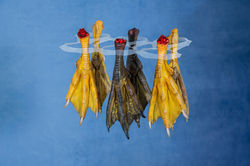 |  |  |  |
|---|---|---|---|
 |  |  |  |
 |
After Humans is an attempt to reckon with the damage humankind has committed against our planet and wildlife. These images ask viewers to recognize and acknowledge the major problems we are creating in the environment and begs them to alter their behavior and be more respectful of our home. The images ask the question “what will life look like in the midst of abandoned and uncontained human refuse?” and displays the struggle between harmful goods and living organisms.
With the exception of The Bigger Picture, the images display simplified imaginative depictions of a dystopic future in which all that is left after we effectively destroy the environment are non-biodegradable materials, such as plastic and Styrofoam, and the most resilient plant species, like mushrooms and fungus. Each scene combines harmful products with an often endangered animal or plant that they are threatening. In After Humans 1-3, the mushrooms combine with the Styrofoam heads. While mushrooms are natural decomposers, even they will not be able to breakdown the Styrofoam which is estimated to take at least 400 years to decay in nature. Skip the Straw depicts a turtle shell skewered with plastic straws. This image was inspired by the viral 2015 video of marine biologist Christine Figgener removing a straw from a sea turtle’s nose. Thank You Plastic underscores the pollution of plastic in the ocean and also alludes to consumerism, the motivating force behind plastic waste. Additionally, over 4 million sea horses are estimated to be hunted and sold on the black market every year. So much of marine life is explicitly threatened by our waste. Animals confuse microplastics for food or get tangled in six pack rings and plastic nets, leading to permanent deformation or the inability to migrate and eat. Additionally, the waste in the oceans, not to mention minor bodies of water, turns them into huge carbon dioxide sinks which contributes to climate change. The other images contain similar messages in relation to other human products and behaviors that are threatening life on land and in water.
The Bigger Picture confronts viewers with these same thoughts, but prominently blames them and the rest of the human race for environmental barbarities by saying “the blood is on your hands.” The Monarch butterfly is becoming endangered for two primary reasons: through deforestation we are eradicating milkweed, Monarchs’ premier source of food, and climate change is making many areas where it was abundant too warm for it to grow.
My hope is that these images will coerce viewers to contemplate their role in this looming desolation and convince them to be more eco-friendly.